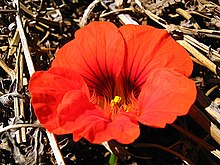| Revision as of 16:52, 19 April 2012 editKazvorpal (talk | contribs)Autopatrolled, Extended confirmed users14,184 edits →Cultivation and uses← Previous edit | Revision as of 16:53, 19 April 2012 edit undoKazvorpal (talk | contribs)Autopatrolled, Extended confirmed users14,184 editsm →Companion plantsNext edit → | ||
| Line 38: | Line 38: | ||
| ===Companion plants=== | ===Companion plants=== | ||
| {{see-also| |
{{see-also|List of companion plants}} | ||
| Nasturtiums are also considered widely useful ]s. They repel a great many ] pests, like ]s, ]s, and several caterpillars. They have a similar range of benefits for ] plants, especially ] and ]. They also serve as a ] against black fly ]. They also attract beneficial predatory insects. | Nasturtiums are also considered widely useful ]s. They repel a great many ] pests, like ]s, ]s, and several caterpillars. They have a similar range of benefits for ] plants, especially ] and ]. They also serve as a ] against black fly ]. They also attract beneficial predatory insects. | ||
Revision as of 16:53, 19 April 2012
This article is about the flowering plants of the genus Tropaeolum, commonly called nasturtiums. For the genus of watercresses, see Nasturtium (genus).
| Tropaeolum | |
|---|---|

| |
| Tropaeolum majus | |
| Scientific classification | |
| Kingdom: | Plantae |
| (unranked): | Angiosperms |
| (unranked): | Eudicots |
| (unranked): | Rosids |
| Order: | Brassicales |
| Family: | Tropaeolaceae |
| Genus: | Tropaeolum L. |
| Species | |
|
About 80 species, see text. | |
Tropaeolum (/trˈpiːələm/), commonly known as Nasturtium (/næˈstɜːrʃəm/; literally "nose-twister" or "nose-tweaker"), is a genus of roughly 80 species of annual and perennial herbaceous flowering plants and the only genus in the family Tropaeolaceae. It should not be confused with the Watercresses of the genus Nasturtium, of the Mustard family. The genus Tropaeolum, native to South and Central America, includes several very popular garden plants, the most commonly grown being T. majus, T. peregrinum and T. speciosum. The hardiest species is T. polyphyllum from Chile, the perennial roots of which can survive underground when air temperatures drop as low as -15°C (5°F).
They have showy, often intensely bright flowers, and rounded, peltate (shield-shaped) leaves with the petiole in the center. The flowers have five petals (sometimes more), a three-carpelled ovary, and a funnel-shaped nectar tube in the back.
Tropaeolum species are used as food plants by the larvae of some Lepidoptera species including Dot Moth and Garden Carpet. A very common "pest" found on Nasturtium in particular is the caterpillar of the Large White (Cabbage White) Butterfly.
The Nasturtiums receive their name from the fact that they produce an oil that is similar to that produced by Watercress (Nasturtium officinale), from the family Brassicaceae.
Cultivation and uses
In cultivation, most varieties of nasturtiums prefer to be grown in direct or indirect sunlight, with a few preferring partial shade.
The most common use of the nasturtium plant in cultivation is as an ornamental flower. It grows easily and prolifically, and is a self-seeding annual.

All parts of the plant are edible. The flower has most often been consumed, making for an especially ornamental salad ingredient; it has a slightly peppery taste reminiscent of watercress, and is also used in stir fry. The unripe seed pods can be harvested and pickled with hot vinegar, to produce a condiment and garnish, sometimes used in place of capers, although the taste is strongly peppery. The mashua (T. tuberosum) produces an edible underground tuber that is a major food source in parts of the Andes.
Companion plants
See also: List of companion plantsNasturtiums are also considered widely useful companion plants. They repel a great many cucurbit pests, like squash bugs, cucumber beetles, and several caterpillars. They have a similar range of benefits for brassica plants, especially broccoli and cauliflower. They also serve as a trap crop against black fly aphids. They also attract beneficial predatory insects.
Taxonomy
Tropaeolum was previously placed in the family Tropaeolaceae along with two other genera, Magallan and Tropaeastrum. In 2000, a molecular study found Tropaeolum to be paraphyletic with respect to the other 2 genera, so they were transferred into Tropaeolum. Tropaeolaceae was thus rendered monogeneric.
Species
References
- Sunset Western Garden Book, 1995:606–607; "Tropaeolum". Oxford English Dictionary (Online ed.). Oxford University Press. (Subscription or participating institution membership required.)
- "nasturtium". Oxford English Dictionary (Online ed.). Oxford University Press. (Subscription or participating institution membership required.)
- Andersson, Lennart and Andersson, Stephan (2000). "A molecular phylogeny of Tropaeolaceae and its systematic implications". Taxon. 49 (4). Taxon, Vol. 49, No. 4: 721–736. doi:10.2307/1223973. JSTOR 1223973.
{{cite journal}}: CS1 maint: multiple names: authors list (link)
| This article needs additional citations for verification. Please help improve this article by adding citations to reliable sources. Unsourced material may be challenged and removed. Find sources: "Tropaeolum" – news · newspapers · books · scholar · JSTOR (September 2008) (Learn how and when to remove this message) |
External links
- Tropaeolum by J. S. McFarlane
- Chilean Tropaeolum, by Chileflora
- Poor Man's Capers: How to make gourmet capers from nasturtium seed pods